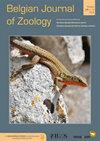Temporal patterns in Cape fur seal (Arctocephalus pusillus pusillus) mother and pup attraction calls
IF 1.1
4区 生物学
Q2 ZOOLOGY
引用次数: 0
Abstract
Vocal recognition is widespread in the animal kingdom, and a necessary tool for offspring survival in some groups. Temporal patterns of animal vocalisations can facilitate communication and convey information such as identity, emotional state, or motivation of the caller. While pinniped (i.e., walrus, eared and true seals) vocalisations are generally well studied, and captive pinnipeds show strong timing abilities, little is known about the temporal structure of their calls in the wild. Here, we followed Cape fur seals (Arctocephalus pusillus pusillus) during spontaneous search efforts at the Cape Cross Seal Reserve in Namibia. To investigate the temporal and rhythmic patterning of Cape fur seal attraction calls, we analysed call bouts of 80 mothers and 148 pups. We assessed the relative vocal efforts undertaken by mothers and pups by calculating calling rates, inter-call intervals (periods of silence between vocalisations), and the total time spent calling per bout. To explore the rhythmic structure of the calls, we visualised their temporal patterns by plotting the calling events and frequency histograms of the inter-onset-intervals between each two consecutive vocalisations in a bout. A normalized Pairwise Variability Index was calculated for each individual to investigate underlying patterns and compared between mothers and pups. Pups produced more calls per search, vocalised at higher rates, and took shorter breaks between consecutive vocalisations than females. Even though female vocalisations were much longer, there was no significant difference in the total time females and pups spent vocalising per bout. All animals vocalised at seemingly random intervals, with no distinguishable rhythmic pattern, suggesting that these do not encode identity information during mother-pup reunions. However, numerical analysis showed a potential asynchronous patterning within the age classes, possibly used in anti-masking. Our results indicate that Cape fur seal females and pups invest their energy differently during a search, and while their total calling effort is comparable, reunions seem to be driven mostly by the young.Cape毛皮海豹(Arctocephalus pusilus pusilulus)母亲和幼崽吸引叫声的时间模式
声音识别在动物界很普遍,是某些群体后代生存的必要工具。动物发声的时间模式可以促进交流并传达信息,如呼叫者的身份、情绪状态或动机。虽然鳍足类动物(即海象、耳海豹和真海豹)的叫声通常得到了很好的研究,圈养的鳍足类表现出很强的计时能力,但人们对它们在野外叫声的时间结构知之甚少。在这里,我们跟随开普海豹(Arctocephalus pusilus pusilu)在纳米比亚的开普十字海豹保护区进行自发搜索。为了研究开普毛皮海豹吸引叫声的时间和节奏模式,我们分析了80只母海豹和148只幼海豹的叫声。我们通过计算叫声频率、叫声间隔(发声之间的静默期)和每次叫声花费的总时间来评估母亲和幼崽的相对发声努力。为了探索叫声的节奏结构,我们通过绘制叫声事件和一轮中每两次连续发声之间发作间隔的频率直方图,可视化了它们的时间模式。计算每个个体的归一化成对变异指数,以调查潜在模式,并在母亲和幼崽之间进行比较。与雌性相比,幼犬每次搜索发出的叫声更多,发声频率更高,连续发声之间的休息时间更短。尽管雌性发声的时间要长得多,但雌性和幼崽每次发声的总时间没有显著差异。所有动物都以看似随机的间隔发声,没有明显的节奏模式,这表明这些动物在母子团聚期间不会编码身份信息。然而,数值分析显示,年龄段内存在潜在的异步模式,可能用于反掩模。我们的研究结果表明,开普毛皮海豹雌性和幼崽在搜索过程中投入的能量不同,虽然它们的总呼叫量相当,但团聚似乎主要是由幼海豹驱动的。
本文章由计算机程序翻译,如有差异,请以英文原文为准。
求助全文
约1分钟内获得全文
求助全文
来源期刊

Belgian Journal of Zoology
生物-动物学
CiteScore
1.90
自引率
0.00%
发文量
10
审稿时长
>12 weeks
期刊介绍:
The Belgian Journal of Zoology is an open access journal publishing high-quality research papers in English that are original, of broad interest and hypothesis-driven. Manuscripts on all aspects of zoology are considered, including anatomy, behaviour, developmental biology, ecology, evolution, genetics, genomics and physiology. Manuscripts on veterinary topics are outside of the journal’s scope. The Belgian Journal of Zoology also welcomes reviews, especially from complex or poorly understood research fields in zoology. The Belgian Journal of Zoology does no longer publish purely taxonomic papers. Surveys and reports on novel or invasive animal species for Belgium are considered only if sufficient new biological or biogeographic information is included.
 求助内容:
求助内容: 应助结果提醒方式:
应助结果提醒方式:


